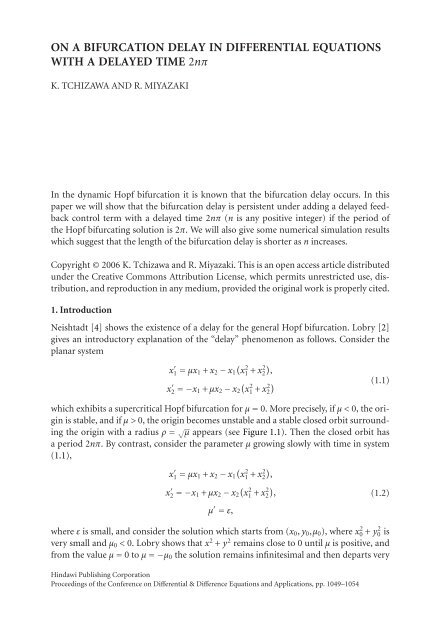DIFFERENtIAl & DIFFERENCE EqUAtIONS ANd APPlICAtIONS
DIFFERENtIAl & DIFFERENCE EqUAtIONS ANd APPlICAtIONS
DIFFERENtIAl & DIFFERENCE EqUAtIONS ANd APPlICAtIONS
Create successful ePaper yourself
Turn your PDF publications into a flip-book with our unique Google optimized e-Paper software.
ON A BIFURCATION DELAY IN DIFFERENTIAL EQUATIONS<br />
WITH A DELAYED TIME 2nπ<br />
K. TCHIZAWA AND R. MIYAZAKI<br />
In the dynamic Hopf bifurcation it is known that the bifurcation delay occurs. In this<br />
paper we will show that the bifurcation delay is persistent under adding a delayed feedback<br />
control term with a delayed time 2nπ (n is any positive integer) if the period of<br />
the Hopf bifurcating solution is 2π. We will also give some numerical simulation results<br />
which suggest that the length of the bifurcation delay is shorter as n increases.<br />
Copyright © 2006 K. Tchizawa and R. Miyazaki. This is an open access article distributed<br />
under the Creative Commons Attribution License, which permits unrestricted use, distribution,<br />
and reproduction in any medium, provided the original work is properly cited.<br />
1. Introduction<br />
Neishtadt [4] shows the existence of a delay for the general Hopf bifurcation. Lobry [2]<br />
gives an introductory explanation of the “delay” phenomenon as follows. Consider the<br />
planar system<br />
x 1 ′ = μx (<br />
1 + x 2 − x 1 x<br />
2<br />
1 + x2) 2 ,<br />
x 2 ′ =−x (<br />
1 + μx 2 − x 2 x<br />
2<br />
1 + x2<br />
2 ) (1.1)<br />
which exhibits a supercritical Hopf bifurcation for μ = 0. More precisely, if μ0, the origin becomes unstable and a stable closed orbit surrounding<br />
the origin with a radius ρ = √ μ appears (see Figure 1.1). Then the closed orbit has<br />
aperiod2nπ. By contrast, consider the parameter μ growing slowly with time in system<br />
(1.1),<br />
x ′ 1 = μx 1 + x 2 − x 1<br />
( x<br />
2<br />
1 + x 2 2) ,<br />
x ′ 2 =−x 1 + μx 2 − x 2<br />
( x<br />
2<br />
1 + x 2 2) ,<br />
μ ′ = ε,<br />
(1.2)<br />
where ε is small, and consider the solution which starts from (x 0 , y 0 ,μ 0 ), where x 2 0 + y 2 0 is<br />
very small and μ 0 < 0. Lobry shows that x 2 + y 2 remains close to 0 until μ is positive, and<br />
from the value μ = 0toμ =−μ 0 the solution remains infinitesimal and then departs very<br />
Hindawi Publishing Corporation<br />
Proceedings of the Conference on Differential & Difference Equations and Applications, pp. 1049–1054

















